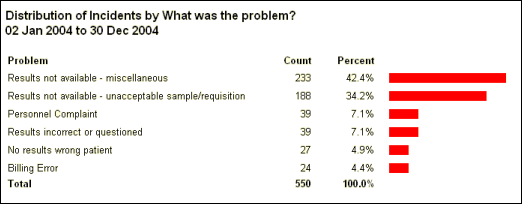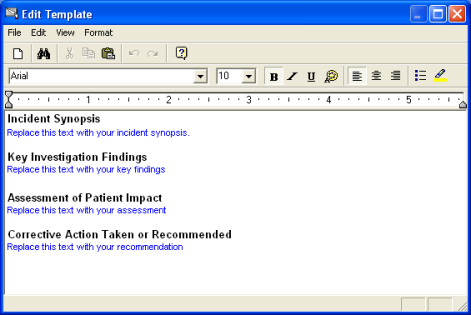Glossary
Archive
Process of removing incidents prior to a cutoff date from the live database and placing them in a separate history (archive) file.
Big Picture
A report that summarizes important characteristics of the database (see Example of the "Big Picture" Report)
Breakdown Report
A report that shows the distribution of incidents by some classifier. For example:

Code Sheet
A report that shows the number-codes of pick list values (used in designing an import file)
Cognitive
Cognitive errors are mistakes that involve misinterpretation of results or faulty decision making on the part of the technologist.
Examples:
Failure to properly interpret a common instrument flag
Mistaking yeasts for host cells on a Gram stain
Calling in a critical value to a voice mailbox, despite knowing that the policy is that the care provider must accept the value directly.
In contrast, non-cognitive errors are slips due to a lapse in attention while performing routine or repetitive tasks.
Examples:
Failure to enter information from a requisition into the LIS
Data entry errors
Mislabeling
Math errors
Database Repair
see Repair
Demo Database
see Live Database
Filter
A set of conditions to limit what incidents are displayed.
Example: Show incident reports that:
Occurred during March, 2004, and
Occurred in the Pre-analytic phase, and
Resulted in serious harm to the patient
Incident
Also known as Error, Problem, Mistake, Event, Adverse Event
Live Database
The database where real incidents in your lab are recorded. There is only one live database. Demo databases are provided when the software is installed to help you become familiar with the program's capabilities. When you are using a demo database, the word DEMO is printed on many of the screens in large red letters, so you won't accidentally enter a real incident in the wrong place.
Pick List
The list of possible values for a incident classifier.
Example:
Field: Laboratory Function
Pick List: Phlebotomy, Processing, Chemistry, etc
Repair
The process of rebuilding the database indices when mysterious problems -- like incorrect sort orders -- begin to occur.
Setup
The process of defining what fields will appear on the input form, and possible values for them. You cannot enter incident reports until the Setup process is complete.
Severity
A numeric rank ranging from 1 to 3 that indicates how serious a patient outcome is. 1-No effect, 2-Minor, 3-Serious.
Examples of Minor impact:
Redraw or recollection of specimen
Additional unnecessary laboratory tests performed
Delay in diagnosis or treatment
Effect on medical management without change in outcome (change in drug dose, IV fluids, etc)
Examples of Serious impact:
Effect on medical management possibly contributing to adverse outcome
Unnecessary transfusion given
Non-indicated invasive procedure performed
Indicated invasive procedure delayed or canceled
Patient death associated with incident
Template
A Template contains boiler-plate text to guide the operator in entering the free-form text description of an incident. When a new incident report is created, its Description field is initialized from the template. The operator can then type over "instruction" text, replacing it with the appropriate content.
Template Example:

Unassigned
The default value assigned to a pick list field when it is first created. In a yes/no field, Unassigned is not the same as No; it is more like "I don't know" or "not entered yet". If you add a new pick list field to your input form after you have already entered Incident reports, its value for previously-entered incidents is set to Unassigned.